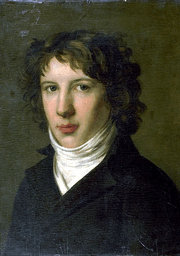Louis de Saint-Just
|
|
Antoine Louis Léon de Richebourg de Saint-Just (August 25, 1767 - July 28, 1794), usually referred to simply as Saint-Just, was a French revolutionary leader. Closely allied with Robespierre, he served with him on the Committee of Public Safety and perished with him after the events of 9 Thermidor.
Born at Decize in the Nivernais, he joined the revolution at its outbreak, was elected an officer in the National Guard of the Aisne, and falsified his age to become a member of the electoral assembly of his district. Early in 1789 he had published twenty cantos of licentious verse, in the fashion of the time, under the title of Organt au Vatican. Afterwards, however, he assumed a stoical manner, which, together with his tyrannical and pitilessly thorough attitude, became a lifelong characteristic.
He entered into correspondence with Maximilien Robespierre, who, flattered by his worship, befriended him. Thus supported, Saint-Just became deputy of the départment of Aisne to the National Convention, where he made his first speech on the condemnation of Louis XVI -- gloomy, fanatical, remorseless in tone -- on November 13, 1792. In the Convention, in the Jacobin Club, and among the populace, his relations with Robespierre became known, and he was dubbed the "St. John of the Messiah of the People." His appointment as a member of the Committee of Public Safety placed him at the centre of the political fever-heat.
In the name of this committee he was given the job of drawing up reports to the Convention on the absorbing themes of the overthrow of the party of the Gironde (report of July 8, 1793), of the Hébertists, and finally, of the denunciation of Georges Danton which consigned him and his followers to the guillotine. His "reports" were rhetorical appeals, displaying fanatical daring, gloomy eloquence, and undoubted genius; and with the shadow of Robespierre behind him they served their purpose. Camille Desmoulins mockingly said of Saint-Just - the youth with the beautiful countenance and the long fair locks - "He carries his head like a Holy Sacrament." "And I," savagely replied Saint-Just, "will make him carry his like a Saint Denis." The threat was not vain: Desmoulins accompanied Danton to the scaffold.
The same ferocious inflexibility animated Saint-Just with reference to the external policy of France. He proposed that the National Convention should itself, through its committees, direct all military movements and all branches of the government (report of October 10, 1793). This was agreed to, and Saint-Just was despatched to Strasbourg, in company with another deputy, to superintend the military operations. It was suspected that the enemy without was being aided by treason within. Saint-Just's remedy was to follow his experience in Paris, organise the Reign of Terror, and soon the heads of all suspects sent to Paris were falling under the guillotine. There were no executions at Strasbourg, and Saint-Just repressed the excesses of Jean-Georges Schneider, who as public prosecutor to the revolutionary tribunal of the Lower Rhine had ruthlessly applied the Terror in Alsace. Schneider was sent to Paris and guillotined.
The conspiracy was defeated, and the armies of the Rhine and Moselle having been inspirited by success - Saint-Just himself taking a fearless part in the actual fighting - and having effected a junction, the frontier was delivered and Germany invaded. On his return Saint-Just was made president of the Convention. Later, with the army of the North, he placed before the generals the dilemma of victory over the enemies of France or trial by the dreaded revolutionary tribunal; and before the eyes of the army itself he organized a force specially charged with the slaughter of those who should seek refuge by flight. Success again crowned his efforts, and Belgium was gained for France (May, 1794).
Meanwhile affairs in Paris looked gloomier than ever, and Robespierre recalled Saint-Just to the capital. Saint-Just proposed a dictatorship as the only remedy for the convulsions of society. At last, at the famous sitting of 9 Thermidor, he ventured to present as the report of the committees of General Security and Public Safety a document expressing his own views, a sight of which, however, had been refused to the other members of committee on the previous evening. He was vehemently interrupted, and the sitting ended with an order for Robespierre's arrest. On the following day, July 28, 1794, twenty-two men, nearly all young, were guillotined. Saint-Just maintained his proud self-possession to the last.
References
Please update as needed.
The 1911 Encyclopaedia Britannica, in turn, gives as its references:
- Œuvres de Saint-Just, précédes d'une notice historique sur sa vie (Paris, 1833-1834)
- E Fleury, Etudes révolutionnaires (2 vols., 1851), with which cf. articles by Sainte Beuve (Causeries du lundi, vol. v), Cuvillier-Fleury (Portraits politiques et révolutionnaires)
- E Hamel, Histoire de Saint-Just (1859), which brought a fine to the publishers for outrage on public decency
- FA Aulard, Les Orateurs de la Legislative et de la Convention (2nd ed., Paris, 1905).
- The Œuvres complètes de Saint-Just have been edited with notes by C Vellay (Paris, 1908).de:Antoine de Saint-Just
fr:Louis Antoine Léon de Saint-Just ja:ルイ・アントワーヌ・ド・サン・ジュスト sl:Louis Antoine Léon de Saint-Just

